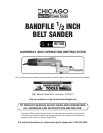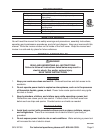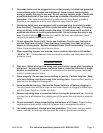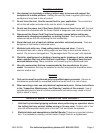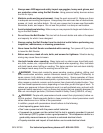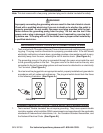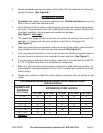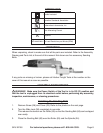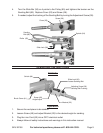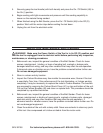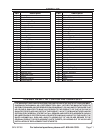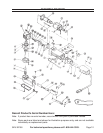
Page 5SKU 92158
For technical questions, please call 1-800-444-3353.
Always wear ANSI-approved safety impact eye goggles, heavy work gloves, and
ear protection when using the Belt Sander. Using personal safety devices reduce
the risk for injury.
Maintain a safe working environment. Keep the work area well lit. Make sure there
is adequate surrounding workspace. Always keep the work area free of obstructions,
grease, oil, trash, and other debris. Do not use a power tool in areas near flammable
chemicals, dusts, and vapors. Do not use this product in a damp or wet location.
Avoid unintentional starting. Make sure you are prepared to begin work before turn-
ing on the Belt Sander.
Do not force the Belt Sander. This tool will do the work better and safer at the speed
and capacity for which it was designed.
Always unplug the Belt Sander from its electrical outlet before performing any
inspection, maintenance, or cleaning procedures.
Never leave the Belt Sander unattended while running. Turn power off if you have
to leave the Belt Sander.
Before each use, check all nuts, bolts, and screws for tightness. Vibration during
mixing may cause these to loosen.
Use both hands when operating. Many tools such as chain saws, hand-held sand-
ers, drills, routers, etc., require the use of both hands when operating. Also, hold stock
with both hands when buffing or sanding. This helps maintain tool and stock stability
and keeps hands away from the working area of the tool.
WARNING! Some dust created by power sanding, sawing, grinding, drilling, and
other construction activities, contain chemicals known (to the State of California) to
cause cancer, birth defects or other reproductive harm. Some examples of these
chemicals are: lead from lead-based paints, crystalline silica from bricks and cement or
other masonry products, arsenic and chromium from chemically treated lumber. Your
risk from these exposures varies, depending on how often you do this type of work. To
reduce your exposure to these chemicals: work in a well ventilated area, and work with
approved safety equipment, such as those dust masks that are specially designed to
filter out microscopic particles. (California Health & Safety Code § 25249.5, et seq.)
WARNING! People with pacemakers should consult their physician(s) before us-
ing this product. Electromagnetic fields in close proximity to a heart pacemaker could
cause interference to or failure of the pacemaker.
In addition, people with pacemakers should adhere to the following:
Avoid operating power tools alone.
Don’t use a power tool with the power switch locked on.
If powered via a power cord be certain that the tool is properly grounded. A ground
fault interrupt (GFCI) system is also a good precaution. This inexpensive device is a
good safety measure because it prevents a sustained electrical shock.
Properly maintain and inspect all tools before use to avoid electrical shock.
3.
4.
5.
6.
7.
8.
9.
10.
11.
12.
•
•
•
•



